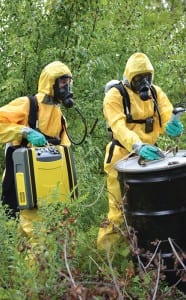OCCUPATIONAL health specialists from Wisconsin, USA, are utilising FTIR gas analysis technology to identify and quantify both known and unknown gas species in a wide variety of applications in which workers are potentially at risk.
The FTIR instrument, a Gasmet DX4040, is owned by North Shore Environmental Construction (NSEC), a specialist in the management of hazardous materials response and environmental challenges. NSEC routinely employs specialist consultants for the more technically complex investigations and Michael McCoy, M.S., CIH, CHMM, CSP from GZA GeoEnvironmental provides a high level of expertise in these applications, which includes evaluation of the data.
 NSEC specializes in hazardous materials response and clean-up and field-based environmental construction. Much of GZA’s work involves site investigation to characterize levels of environmental contamination and human exposure to potentially hazardous or toxic substances. In some cases, such as a chemical spill, the contaminant is known, but in others the source of contamination may not be known. For example, land may have become contaminated by a number of different industrial sources over many years, and waterborne pollution can travel long distances and therefore be derived from unknown sources.
NSEC specializes in hazardous materials response and clean-up and field-based environmental construction. Much of GZA’s work involves site investigation to characterize levels of environmental contamination and human exposure to potentially hazardous or toxic substances. In some cases, such as a chemical spill, the contaminant is known, but in others the source of contamination may not be known. For example, land may have become contaminated by a number of different industrial sources over many years, and waterborne pollution can travel long distances and therefore be derived from unknown sources.
As a portable FTIR gas analyser, the DX4040 effectively enables laboratory grade analysis onsite which dramatically increases the speed with which contamination can be assessed, and avoids the problems, costs and delays associated with transporting samples to a laboratory. Explaining the advantages of FTIR, Michael McCoy says: “Many portable gas monitoring instruments either just measure an individual gas or provide an aggregated reading for a group of compounds – VOCs for example. In contrast, the DX4040 is able to measure up to 25 individual compounds simultaneously. It achieves this by producing a spectrum for the measured compounds, which means that we can set the instrument to display almost live readings for the compounds of potential interest.
McCoy suggests a major advantage of Gasmet’s FTIR analyzers is their ability to identify unknown compounds. “Calcmet software facilitates the identification of unknown peaks in a spectrum by comparison with Gasmet’s vast library of stored spectra.”
McCoy is board certified in the fields of industrial hygiene, hazardous materials management, and safety. However, he is also a medical technologist with a masters in pharmacology and toxicology. Consequently, he is able to provide advice on the toxicological and safety implications of the readings provided by the DX4040. “The ability of the FTIR to analyse multiple compounds is a major advantage; firstly because it enables us to analyse complex mixtures and secondly because it also facilitates the measurement of breakdown products.” He adds: “Once the contaminant profile and concentrations are known, my job is to compare these with internationally accepted safe levels, taking into account the effects of gas mixtures and to advise on any potential health and environmental effects.”
GZA has developed a strong working relationship with NSEC over the last 6 years; NSEC providing emergency response, and GZA delivering clean-up monitoring and site clearance. The DX4040 was purchased from Gasmet in October 2015 and since that time it has helped validate clean-up activities and provide confirmation of safe working conditions during remediation work.
The DX4040 is a relatively recent addition to NSEC’s equipment fleet, however, it has already been employed in a wide variety of applications. For example, it was deployed in a health and safety investigation to measure fumes and breakdown products following a nitric acid leak, and it has also been used to characterise the emissions profile of different processes within a specialist paint factory; analysing a variety of VOCs in the evaporative emissions. In a similar application, the DX4040 was used to characterise the emission from a ceramics manufacturer. In line with the USEPA’s approach to pollution monitoring, such investigations help manufacturers to identify the fate of different chemical species.
Michael says: “In addition to the practical advantages of FTIR analysis, a major benefit for us is the competitive advantage that this technology delivers; clients are really impressed with the quality and speed of the data, which provides reassurance that risks are being effectively managed.”
Prior to the purchase of the DX4040, a practical demonstration was provided by Gasmet’s Jim Cornish at a coffee roasting factory in Wisconsin. Articles in the media had raised concern about lung disease caused by high levels of diacetyl in popcorn manufacturing facilities and coffee roasters. As a result, NSEC and GZA were asked to investigate and this provided an opportunity to evaluate the benefits of portable FTIR. As a result of this investigation it was possible to list the components of the emissions from coffee roasting and to provide reassurance to the factory’s workers that they were not at risk.
Summarizing, Michael says: “Portable FTIR, in the right hands, is a very powerful tool, helping to define the composition of the gaseous contamination, which reduces risk and builds assurance in remediation activities. Looking forward, I believe that this technology will be employed in an increasingly larger number of even more diverse applications.”







